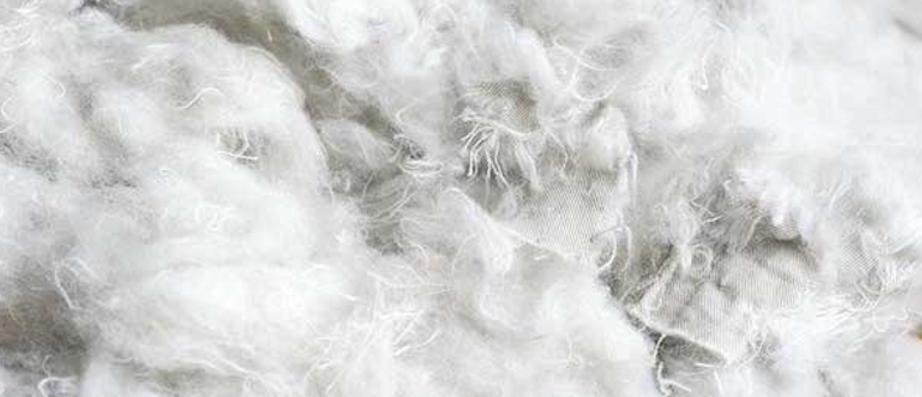
Material: a closer look at cotton (ep. 3)
Episode 3
In this final instalment of our article on the different types of cotton, we'll explain what recycled cotton is, how it's “made”, its advantages and disadvantages, and how it compares with conventional cotton. Let's get started!
Recycled cotton
During the manufacturing process, the workshops cut large strips of fabric according to the garment models they need to make. For each garment made, part of the fabric is lost, becoming scrap material. Negotiated at a more attractive price, these scraps can be saved from the garbage can and then recycled into raw materials. This also limits the amount of waste that ends up in incinerators or in the environment...
Cotton off-cuts are recovered, sorted and then mechanically ground into fibers. This is followed by the spinning and weaving stages, which are the same as for conventional cotton. These fabrics are then returned to the textile production cycle, giving life to new garments or accessories. The loop is closed!
Thanks to this process, the traditional production scheme is challenged to be less harmful to the environment. In fashion, the two phases that generate the greatest impact are the production of raw materials and their shaping. By choosing recycled cotton instead of conventional cotton, environmental impacts are reduced in terms of global warming, eutrophication of water, depletion of resources, respiratory effects on the population and energy consumption. The reduction ranges from 63% to 98% for recycled cotton from production waste, and from 72% to 99% for recycled cotton from post-consumer waste.9
Although recycled cotton requires energy, its energy consumption is much lower than that of standard cotton. It also requires very little water and consumes no pesticides. On the scale of our famous 200g tote bag, the use of recycled fibers requires 99% less water than an equivalent item in conventional cotton. And the CO2 emissions generated are reduced by around 50%! 9,10 Recycling is therefore an alternative worth considering, given that 5.8 million tonnes of textiles are landfilled every year in Europe. 9, 11 Add to this the fact that we buy on average 60% more clothes than we did 15 years ago!11 There is clearly a phenomenon of overproduction on the one hand, and overconsumption on the other.
The other advantage is in terms of logistics, as cotton recycling can be carried out directly in Europe, thus limiting the transportation of raw materials and drastically reducing its carbon footprint compared to conventional cotton, which comes mainly from Asia (China, India, Bangladesh).
Nevertheless, the dominant recycling technology, mechanical recycling, produces shorter fibers than virgin cotton. This process somewhat deteriorates the quality of the fibers and impacts the durability of the fabric, which cannot be recycled indefinitely. This is why it is so difficult to find a high percentage of recycled content in materials; recycled cotton is often combined with conventional or organic cotton, or even with other textile fibers, in order to meet the quality standards of the market (or rather, fast-fashion). 12
A second issue then arises: the recyclability of clothing and textile articles. Sorting is often presented as the first stage in recycling, but for sorting to be possible, manufacturers must have chosen recyclable materials and a garment design that allows recycling. Recycling is therefore also an issue for those upstream in the production chain. Textiles made from a mixture of natural and synthetic materials are more difficult to recycle. Today, however, cotton-polyester blends are used in around a third of all garments produced, and few companies are in a position to recycle them properly. 12 It's best to design with a single material (fabric, yokes, thread, etc.) and accessories that are easy to remove, ideally also recyclable (buttons, zips, zippers) and manufactured under respectful conditions.
With the arrival of this new type of business comes the need to establish a legal framework and control standards to ensure that the positive impacts of textile recycling are real (the same applies to other materials recycled and then recovered, such as PET or nylon). There are two labels for fibers and/or articles made from recycled raw materials: RCS 100 and GRS.
The RCS 100 (Recycled Claim Standard) is used as a means of monitoring recycled raw materials throughout the supply chain. The RCS label verifies the presence and quantity of a recycled component in a final product. Inputs and chain of custody must be verified by a third-party organization. The RCS label is intended for products containing at least 5% recycled materials.
The objectives of the GRS (Global Recycled Standard) are far more demanding than those of the RCS. The internationally recognized GRS label is a standard designed to meet the need for transparency on the composition of recycled materials and on responsible social, environmental and chemical practices in the supply chain and during production. To qualify for the label, a product (and its packaging) must contain a minimum of 50% recycled fiber, and the percentage must be clearly indicated on the label.
Once again, Inovacomm has chosen to work with the most comprehensive certification. As mentioned above, the idea is to have access to a tool that enables better control, and thus greater confidence in the commercial relationship with our partner factories. We also want to encourage innovation in the use of recycled materials. Finally, we believe it is vital to establish greater transparency in the supply chain and provide better information to our customers, so that they can make their purchases with a clear conscience.
Sources:
9) https://www.dotheretex.eu/fr/
10) https://www.purewaste.com/
12) https://www.ellenmacarthurfoundation.org/
Photo: The Good Goods


